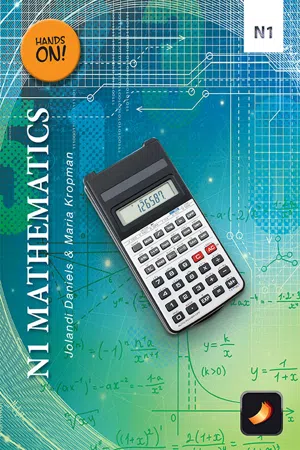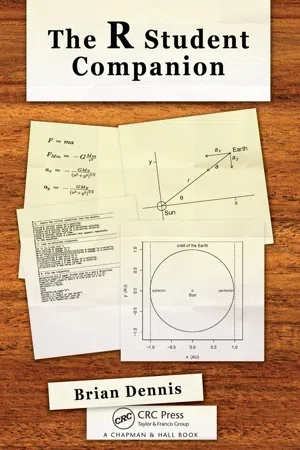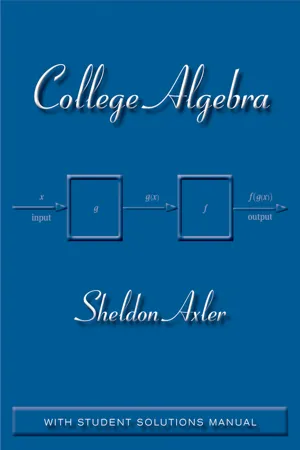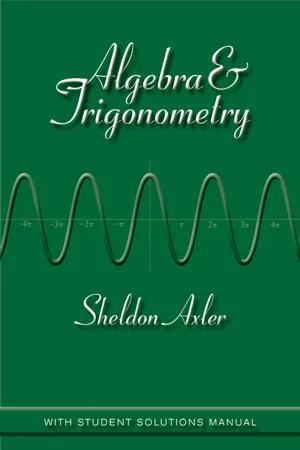Mathematics
Exponentials and Logarithms
Exponentials and logarithms are inverse operations that are commonly used in mathematics. Exponentials involve raising a number to a certain power, while logarithms are used to find the exponent to which a specific base must be raised to produce a given number. These concepts are fundamental in various mathematical applications, including solving equations, modeling growth and decay, and analyzing data.
Written by Perlego with AI-assistance
Related key terms
1 of 5
10 Key excerpts on "Exponentials and Logarithms"
- Available until 8 Feb |Learn more
- J Daniels, M Kropman, J Daniels, M Kropman(Authors)
- 2014(Publication Date)
- Future Managers(Publisher)
1 MODULE Exponents and logarithms 1.1 Exponents On completion of this topic, you should be able to: 1.1.1 Identify the sign, coefficient, base and exponent of a power 1.1.2 Give the laws of exponents 1.1.3 Apply the laws for exponents in simplifying algebraic expressions. 1.2 Logarithms On completion of this topic, you should be able to: 1.2.1 Define a logarithm 1.2.2 Give the following three laws of logarithms: i) log a xy = log a x + log a y ii) log a x y = log a x – log a y iii) log a x n = n log a x , where a = e , 2 and 10 1.2.3 Simplify simple logarithmic expressions without the use of a calculator 1.2.4 Simplify logarithms using a calculator. 2 Module 1 • Exponents and logarithms 1.1 Exponents (indices) Introduction An exponent (index) is a mathematical way of representing a very large number or a very small number in a format that is user-friendly. It is more or less a shorthand notation for multiplying the same number by itself several times, for example: 2 × 2 × 2 × 2 × 2 = 2 5 = 32 Scientific notation is used to express numbers in a manageable form, for example: 11 000 000 000 = 1,1 × 10 10 and 0,000011 = 1,1 × 10 –5 Every computer programmer has to learn exponents. For example, the term nanometre means 10 –9 metre. In the computer world we work with megabytes ( mega means 10 6 or one million), gigabytes ( giga : 10 9 ) and terabytes ( tera : 10 12 ). Exponents are also used in everyday life when we speak about square metres (m 2 ), square kilometres (km 2 ) or any other area units, or when we speak about cubic metres (m 3 ), cubic centimetres (cm 3 ) or any other volume units, for example: to lay carpets in your room you will need 3 × 4 m 2 carpeting. Scientist use exponents to measure the size of an earthquake. 1.1.1 The sign, coefficient, base and exponent of a power Definitions A coefficient is the numerical part of the expression. - eBook - PDF
The Calculus Lifesaver
All the Tools You Need to Excel at Calculus
- Adrian Banner(Author)
- 2009(Publication Date)
- Princeton University Press(Publisher)
C h a p te r 9 Exponentials and Logarithms Here’s a big old chapter on Exponentials and Logarithms. After we review the properties of these functions, we need to do some calculus with them. It turns out that there’s a special base, the number e , that works out particularly nicely. In particular, doing calculus with e x and log e ( x ) is a little easier than dealing with 2 x or log 3 ( x ), for example. So we need to spend some time looking at e . There are other things we want to look at as well; all in all, the plan is to check out the following topics: • review of the basics of exponentials and logs, and how they are related to each other; • the definition and properties of e ; • how to differentiate exponentials and logs; • how to solve limit problems involving exponentials and logs; • logarithmic differentiation; • exponential growth and decay; and • hyperbolic functions. 9.1 The Basics Before you start doing calculus with Exponentials and Logarithms, you really need to understand their properties. Basically, in addition to the actual def-inition of logs, you need to know three things: the exponential rules, the relationship between logs and exponentials, and the log rules. 9.1.1 Review of exponentials The rough idea is that we’ll take a positive number, called the base , and raise it to a power called the exponent : base exponent . For example, the number 2 -5 / 2 is an exponential with base 2 and exponent -5 / 2. It’s essential that you know the so-called exponential rules, which 168 • Exponentials and Logarithms effectively tell you how exponentials work. You’ve seen these before, no doubt, but here they are again to remind you. For any base b > 0 and real numbers x and y : 1. b 0 = 1 . The zeroth power of any nonzero number is 1. 2. b 1 = b. The first power of a number is just the number itself. 3. b x b y = b x + y . When you multiply two exponentials with the same base, you add the exponents. - eBook - PDF
College Algebra
Building Skills and Modeling Situations
- Charles P. McKeague, Katherine Yoshiwara, Denny Burzynski(Authors)
- 2013(Publication Date)
- XYZ Textbooks(Publisher)
Chapter Outline 6.1 Exponential Functions 6.2 The Inverse of a Function 6.3 Logarithms Are Exponents 6.4 Properties of Logarithms 6.5 Common Logarithms and Natural Logarithms 6.6 Exponential Equations and Change of Base Study Skills 414 Never mistake activity for achievement. — John Wooden, legendary UCLA basketball coach You may think that this John Wooden quote has to do with being productive and efficient, or using your time wisely, but it is really about being honest with your- self. I have had students come to me after failing a test saying, “I can’t understand why I got such a low grade after I put so much time in studying.” One student even had help from a tutor and felt she understood everything that we covered. After asking her a few questions, it became clear that she spent all her time studying with a tutor and the tutor was doing most of the work. The tutor can work all the home- work problems, but the student cannot. She has mistaken activity for achievement. Can you think of situations in your life when you are mistaking activity for achievement? How would you describe someone who is mistaking activity for achievement in the way they study for their math class? Which of the following best describes the idea behind the John Wooden quote? ▶ Always be efficient. ▶ Don’t kid yourself. ▶ Take responsibility for your own success. ▶ Study with purpose. 6.1 Exponential Functions 415 6.1 INTRODUCTION To obtain an intuitive idea of how exponential functions behave, we can consider the heights attained by a bouncing ball. When a ball used in the game of racquetball is dropped from any height, the first bounce will reach a height that is 2 _ 3 of the original height. The second bounce will reach 2 _ 3 of the height of the first bounce, and so on, as shown in Figure 1. If the ball is initially dropped from a height of 1 meter, then during the first bounce it will reach a height of 2 _ 3 meter. - eBook - PDF
Precalculus
A Prelude to Calculus
- Sheldon Axler(Author)
- 2016(Publication Date)
- Wiley(Publisher)
A rigorous approach to this question would take us beyond material appropriate for a precal- culus course. Thus we will rely on our intuitive sense of the loose definition given above. The next box summarizes the key algebraic properties of exponents. These are the same properties we saw earlier, but now we have extended the meaning of exponents to a larger class of numbers. Section 3.1 Logarithms as Inverses of Exponential Functions 205 Algebraic properties of exponents Suppose a and b are positive numbers and x and y are real numbers. Then b x b y = b x+y , (b x ) y = b xy , a x b x = (ab) x , b 0 = 1, b -x = 1 b x , b x b y = b x-y , a x b x = a b x . Now that we have defined b x for every positive number b and every real number x, we can define an appropriate function. Exponential function Suppose b is a positive number, with b 6 = 1. Then the exponential function with base b is the function f defined by f ( x) = b x . For example, taking b = 2, we have the exponential function f with base 2 x The graph of the exponential function 2 x on the interval [-5, 5]. Here the same scale is used on both axes to emphasize the rapid growth of this function. defined by f ( x) = 2 x . Be careful to distinguish the function 2 x from the function x 2 . The graphs of these functions have different shapes, as can be seen in the graphs here. The function g defined by g( x) = x 2 is not an exponential function. For an exponential function such as the function f defined by f ( x) = 2 x , the variable x appears in the exponent. x The graph of x 2 on the interval [-3, 3]. Unlike the graph of 2 x , the graph of x 2 is symmetric about the vertical axis. Our main interest is in exponential functions with base b > 1. The next box summarizes the behavior of such functions. Behavior of exponential functions Suppose b > 1 and f is the exponential function defined by f ( x) = b x . - eBook - PDF
- Brian Dennis(Author)
- 2016(Publication Date)
- Chapman and Hall/CRC(Publisher)
Because y x = e means x y = ( ) l og , we can think of taking logarithms of both sides of y x = e in order to bring down x : y x = e , l og l og y x x ( ) = ( ) = . e The exponential and logarithmic functions are inverse functions of each other. Inverse here does not mean one is the reciprocal of the other. Rather, it means one erases the other’s doings: l og e x x ( ) = , e l og y y ( ) = , 175 Exponential and Logarithmic Functions where x is a real number and y is a positive real number. Raising e to a power x is sometimes called “taking the antilogarithm of x ” and is accessed on some scientific calculators as “ inv-log ” or “ inv-ln .” Also, if a is a positive real number, then a a = ( ) e l og and, so, taking the loga-rithm of a x brings down x multiplied by l o g a ( ) : a x a x = ( ) [ ] e l og , l og l og . a a x x ( ) = ( ) [ ] The above formula is the key to going back and forth between logarithms in base e and other bases. If y a a x y a x a = = = ( ) ( ) [ ] , l og l og e then l og l og l og y a y a ( ) = ( ) [ ] ( ) ⎡ ⎣ ⎤ ⎦ , and so the log to any base a expressed in terms of base e logarithms is l og l og l og a y y a ( ) = ( ) ⎡ ⎣ ⎤ ⎦ ( ) [ ] / . In R, a function for l og a y ( ) is log(y,a). Logarithmic Scales In science, some phenomena are measured for convenience on a logarithmic scale. A logarithmic scale might be used for a quantity that has an enormous range of values or that varies multiplicatively. Richter Scale A well-known example of a logarithmic scale is the Richter scale for measur-ing the magnitude of earthquakes. The word magnitude gives a clue that the scale is logarithmic. Richter magnitude is defined as the base 10 logarithm of the amplitude of the quake waves recorded by a seismograph (amplitude is the distance of departures of the seismograph needle from its central refer-ence point). Each whole number increase in magnitude represents a quake with waves measuring 10 times greater. - eBook - PDF
- Cynthia Y. Young(Author)
- 2021(Publication Date)
- Wiley(Publisher)
We call this exponent a logarithm (or “log” for short). Words Math x = b y is equivalent to y = log b x. y = log b x Let y = f −1 (x). f −1 (x) = log b x Logarithmic Function For x > 0, b > 0, and b ≠ 1, the logarithmic function with base b is denoted f (x) = log b x, where y = log b x if and only if x = b y We read log b x as “log base b of x.” 5.2 Logarithmic Functions and Their Graphs 441 STUDY TIP log b x = y is equivalent to b y = x. This definition says that x = b y (exponential form) and y = log b x (logarithmic form) are equivalent. One way to remember this relationship is by adding arrows to the logarithmic form: log b x = y ⇔ b y = x EXAMPLE 1 Changing from Logarithmic Form to Exponential Form Write each equation in its equivalent exponential form. a. log 2 8 = 3 b. log 9 3 = 1 _ 2 c. log 5( 1 __ 25 ) = −2 Solution a. log 2 8 = 3 is equivalent to 2 3 = 8 b. log 9 3 = 1 _ 2 is equivalent to 9 1/2 = 3 c. log 5( 1 __ 25 ) = −2 is equivalent to 5 −2 = 1 __ 25 Your Turn Write each equation in its equivalent exponential form. a. log 3 9 = 2 b. log 16 4 = 1 _ 2 c. log 2( 1 _ 8 ) = −3 Answer a. 3 2 = 9 b. 16 1/2 = 4 c. 2 −3 = 1 _ 8 EXAMPLE 2 Changing from Exponential Form to Logarithmic Form Write each equation in its equivalent logarithmic form. a. 16 = 2 4 b. 9 = √ _ 81 c. 1 _ 9 = 3 −2 d. x a = z Solution a. 16 = 2 4 is equivalent to log 2 16 = 4 b. 9 = √ _ 81 = 81 1/2 is equivalent to log 81 9 = 1 _ 2 c. 1 _ 9 = 3 −2 is equivalent to log 3( 1 _ 9 ) = −2 d. x a = z is equivalent to log x z = a Your Turn Write each equation in its equivalent logarithmic form. a. 81 = 9 2 b. 12 = √ _ 144 c. 1 __ 49 = 7 −2 d. y b = w Answer a. log 9 81 = 2 b. log 144 12 = 1 _ 2 c. log 7 ( 1 _ 49 ) = −2 d. log y w = b 442 CHAPTER 5 Exponential and Logarithmic Functions Some logarithms can be found exactly, whereas others must be approximated. Example 3 illustrates how to find the exact value of a logarithm. Example 4 illustrates approximating values of logarithms with a calculator. - eBook - PDF
- Linda Almgren Kime, Judith Clark, Beverly K. Michael(Authors)
- 2018(Publication Date)
- Wiley(Publisher)
Rules for Exponents If a is any positive real number and n and m are any real numbers, then 1. a n ⋅ a m = a (n+m) 3. (a m ) n = a (m . n) 2. a n /a m = a (n−m) 4. a 0 = 1 Corresponding Rules for Common Logarithms If A and B are positive real numbers and p is any real number, then 1. log (A ⋅ B) = log A + log B 3. log (A p ) = p log A 2. log (A/B) = log A − log B 4. log 1 = 0 (since 10 0 = 1) Finding the common logarithm of a number means finding its exponent when the number is written as a power of 10. So when you see “logarithm,” think “exponent,” and the rules of logarithms make sense. 5. For each of the following, find two consecutive integers for the exponents a and b that would make the statement true. a. 2 a < 13 < 2 b c. 5 a < 0.24 < 5 b b. 3 a < 99 < 3 b d. 10 a < 1500 < 10 b 4. Use the table to determine between which two consecutive inte- gers the value of x in each of the following equations lies. a. 5 x = 73 b. 5 x = 0.36 x 5 x −2 0.04 −1 0.2 0 1 1 5 2 25 3 125 4 625 336 CHAPTER 6 Logarithmic Links: Logarithmic and Exponential Functions As we learned in Chapter 4, the log of 0 or a negative number is not defined. But when we take the log of a number, we can get 0 or a negative value. For example, log 1 = 0 and log 0.1 = −1. Explore and Extend 6.1a Using the Rule of Exponents Try expressing in words the rules for logarithms in terms of exponents. We will list a rationale for each of the rules of common logarithms and prove Rule 1. We leave the other proofs as exercises. Rule 1 log (A ⋅ B) = log A + log B Rationale Rule 1 of exponents says that when we multiply two terms with the same base, we keep the base and add the exponents; that is, a p ⋅ a q = a p+q . Rule 1 of logs says that if we rewrite A and B each as a power of 10, then the exponent of A ⋅ B is the sum of the exponents of A and B. - eBook - PDF
- Jerome Kaufmann, Karen Schwitters, , , Jerome Kaufmann, Karen Schwitters(Authors)
- 2014(Publication Date)
- Cengage Learning EMEA(Publisher)
Due to electronic rights, some third party content may be suppressed from the eBook and/or eChapter(s). Editorial review has deemed that any suppressed content does not materially affect the overall learning experience. Cengage Learning reserves the right to remove additional content at any time if subsequent rights restrictions require it. 11.5 • Exponential Equations, Logarithmic Equations, and Problem Solving 581 by simplifying the left side of the equation to log 10 [ x ( x 1 9)] and then changing the equation to exponential form to complete the solution. Now, using Property 11.8, we can solve such a logarithmic equation another way and also expand our equation-solving capabilities. Let’s consider some examples. Solve log x 1 log( x 2 15) 5 2 . Solution Because log 100 5 2 , the given equation becomes log x 1 log( x 2 15) 5 log 100 Now simplify the left side, apply Property 11.8, and proceed as follows: log( x )( x 2 15) 5 log 100 x ( x 2 15) 5 100 x 2 2 15 x 2 100 5 0 ( x 2 20)( x 1 5) 5 0 x 2 20 5 0 or x 1 5 5 0 x 5 20 or x 5 2 5 The domain of a logarithmic function must contain only positive numbers, so x and x 2 15 must be positive in this problem. Therefore, we discard the solution 2 5 ; the solution set is 5 20 6 . Solve ln( x 1 2) 5 ln( x 2 4) 1 ln 3 . Solution ln( x 1 2) 5 ln( x 2 4) 1 ln 3 ln( x 1 2) 5 ln[3( x 2 4)] x 1 2 5 3( x 2 4) x 1 2 5 3 x 2 12 14 5 2 x 7 5 x The solution set is 5 7 6 . Using Logarithms to Solve Problems In Section 11.2 we used the compound interest formula A 5 P a 1 1 r n b nt to determine the amount of money ( A ) accumulated at the end of t years if P dollars is in-vested at r rate of interest compounded n times per year. Now let’s use this formula to solve other types of problems that deal with compound interest. Apply Your Skill How long will $500 take to double itself if it is invested at 8% interest compounded quarterly? EXAMPLE 3 Classroom Example Solve log x 1 log( x 2 21) 5 2 . - eBook - PDF
- Sheldon Axler(Author)
- 2011(Publication Date)
- Wiley(Publisher)
If your calculator has a button labeled “log”, then it will compute the logarithm base 10, which is often just called the logarithm. section 5.2 Logarithms as Inverses of Exponential Functions 297 Common Logarithms and the Number of Digits Note that 10 1 is a two-digit number, 10 2 is a three-digit number, 10 3 is a four-digit number, and so on. In general, 10 n-1 is an n-digit number. Because 10 n , which consists of 1 followed by n zeros, is the smallest positive integer with n + 1 digits, we see that every integer in the interval [10 n-1 , 10 n ) has n digits. Because log 10 n-1 = n - 1 and log 10 n = n, this implies that an n-digit positive integer has a logarithm in the interval [n - 1, n). Alternative statement: If M is a positive inte- ger with n digits, then n - 1 ≤ log M < n. Digits and logarithms The logarithm of an n-digit positive integer is in the interval [n - 1, n). The conclusion above is often useful in making estimates. For example, without using a calculator we can see that the number 123456789, which has nine digits, has a logarithm between 8 and 9 (the actual value is about 8.09). The next example shows how to use the conclusion above to determine the number of digits in a number from its logarithm. example 3 Suppose M is a positive integer such that log M ≈ 73.1. How many digits does M have? solution Because 73.1 is in the interval [73, 74), we can conclude that M is a Always round up the logarithm of a num- ber to determine the number of digits. Here log M ≈ 73.1 is rounded up to show that M has 74 digits. 74-digit number. Logarithm of a Power We will use the formula (b r ) t = b tr to derive a formula for the logarithm of a power. First we look at an example. To motivate the formula for the logarithm of a power, we note that An expression such as log 10 12 should be interpreted to mean log(10 12 ), not (log 10) 12 . log (10 3 ) 4 = log 10 12 = 12 and log 10 3 = 3. Putting these equations together, we see that log (10 3 ) 4 = 4 log 10 3 . More generally, logarithms convert powers to products, as we will now show. Suppose b and y are positive numbers, with b 6= 1, and t is a real number. Then log b y t = log b (b log b y ) t = log b b t log b y = t log b y. - eBook - PDF
- Sheldon Axler(Author)
- 2011(Publication Date)
- Wiley(Publisher)
If your calculator has a button labeled “log”, then it will compute the logarithm base 10, which is often just called the logarithm. section 5.2 Logarithms as Inverses of Exponential Functions 297 Common Logarithms and the Number of Digits Note that 10 1 is a two-digit number, 10 2 is a three-digit number, 10 3 is a four-digit number, and so on. In general, 10 n-1 is an n-digit number. Because 10 n , which consists of 1 followed by n zeros, is the smallest positive integer with n + 1 digits, we see that every integer in the interval [10 n-1 , 10 n ) has n digits. Because log 10 n-1 = n - 1 and log 10 n = n, this implies that an n-digit positive integer has a logarithm in the interval [n - 1, n). Alternative statement: If M is a positive inte- ger with n digits, then n - 1 ≤ log M < n. Digits and logarithms The logarithm of an n-digit positive integer is in the interval [n - 1, n). The conclusion above is often useful in making estimates. For example, without using a calculator we can see that the number 123456789, which has nine digits, has a logarithm between 8 and 9 (the actual value is about 8.09). The next example shows how to use the conclusion above to determine the number of digits in a number from its logarithm. example 3 Suppose M is a positive integer such that log M ≈ 73.1. How many digits does M have? solution Because 73.1 is in the interval [73, 74), we can conclude that M is a Always round up the logarithm of a num- ber to determine the number of digits. Here log M ≈ 73.1 is rounded up to show that M has 74 digits. 74-digit number. Logarithm of a Power We will use the formula (b r ) t = b tr to derive a formula for the logarithm of a power. First we look at an example. To motivate the formula for the logarithm of a power, we note that An expression such as log 10 12 should be interpreted to mean log(10 12 ), not (log 10) 12 . log (10 3 ) 4 = log 10 12 = 12 and log 10 3 = 3. Putting these equations together, we see that log (10 3 ) 4 = 4 log 10 3 . More generally, logarithms convert powers to products, as we will now show. Suppose b and y are positive numbers, with b = 1, and t is a real number. Then log b y t = log b (b log b y ) t = log b b t log b y = t log b y.
Index pages curate the most relevant extracts from our library of academic textbooks. They’ve been created using an in-house natural language model (NLM), each adding context and meaning to key research topics.









